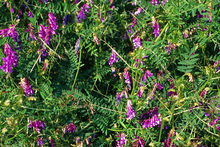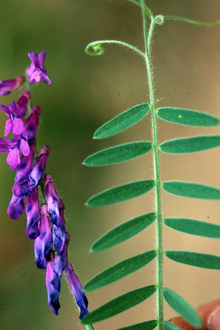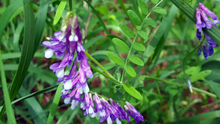Quick facts
Cow vetch and hairy vetch are invasive species.
-
Cow vetch and hairy vetch spread over other vegetation, smothering it.
-
These plants usually don't cause problems in healthy native prairies.
-
Cow and hairy vetch can be problematic in prairie restoration sites or other disturbed areas.
Cow vetch and hairy vetch should be reported. The Minnesota Department of Natural Resources provides detailed recommendations for reporting invasive species.
How to identify cow vetch and hairy vetch
- Cow and hairy vetch (Vicia cracca and V. villosa) is a herbaceous, sprawling, vine-like plant.
- Annual or short-lived perennial.
Stem
- Weak stems grow two to three feet high.
- The stem of cow vetch has sparse short hairs; hairy vetch has long, spreading hairs.
Leaves
- Alternate, pinnately compound with eight to twelve pairs of narrow oval-shaped opposite leaflets.
- Has a terminal tendril that clings to adjacent vegetation.
Flowers
- Violet-blue on cow vetch and blue and white on hairy vetch.
- Flowers are clustered on one-sided spikes; the inflorescence can be up to six inches long.
- Blooms from May to August.
Seeds
- Contained in numerous one inch-long pods.
- Pods of cow vetch are brownish, lance shaped, and flat; pods of hairy vetch are gray to black and hairy.
Roots
- Both plants have one to three feet-long taproot.
- Hairy vetch can spread through rhizomes.
Reviewed in 2019




